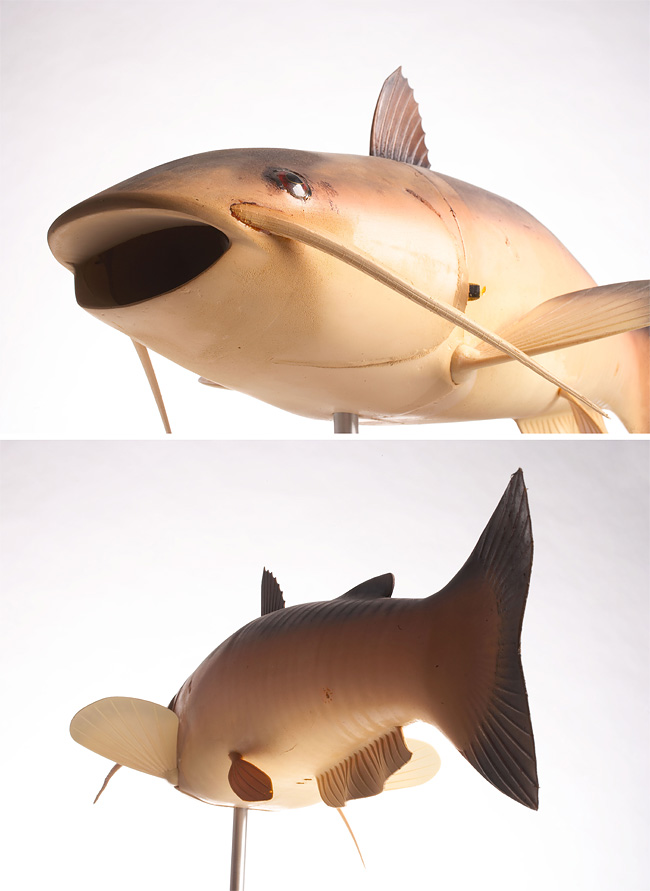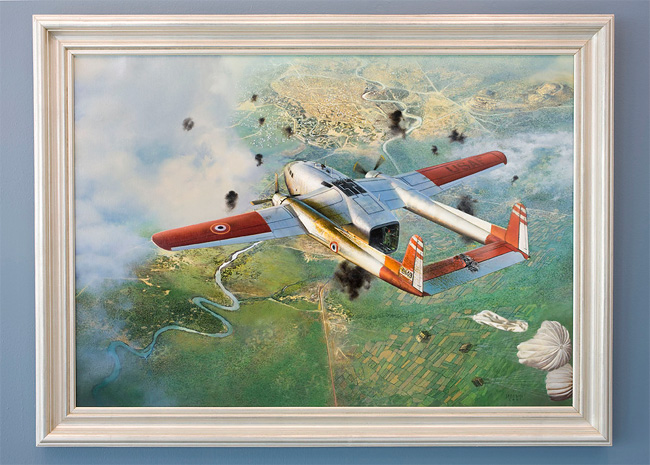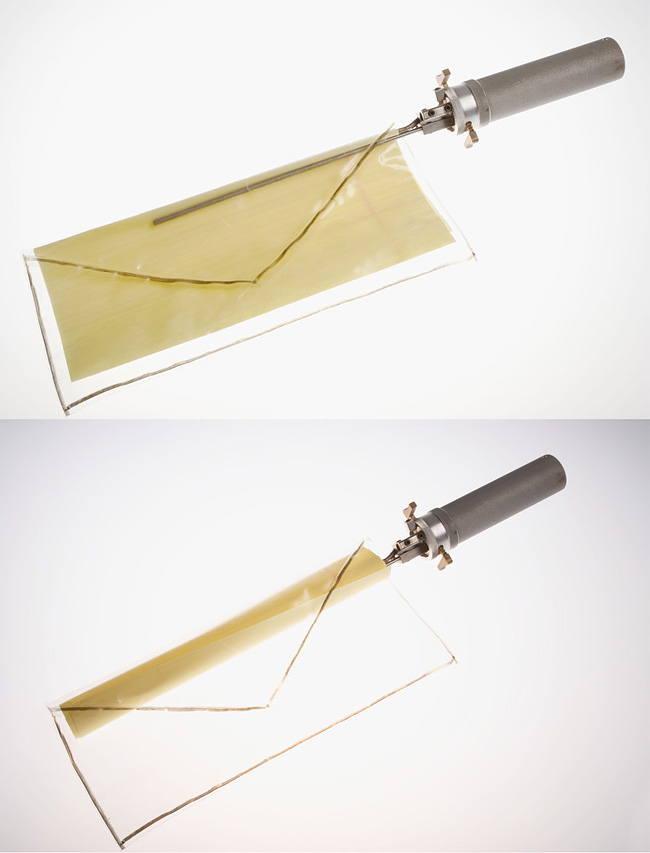Artifacts from the Central Intelligence Agency Museum

An essential part of the survival kit for American forces in the Philippines, China and Burma, this knife was ideal for cutting through jungle brush. It also had potential as a combat knife – its manufacturer provided instructions on how to use the Woodsman’s Pal to defeat a Japanese soldier armed with a samurai sword. (Photo by Central Intelligence Agency)

US Special Operations Forces in Afghanistan used the AN/PEQ-1A SOFLAM to direct exact delivery of ordnance. The SOFLAM was an important tool in the battle for Tora Bora where a CIA US Special Forces team directed 72 hours of unrelenting air strikes – sometimes dangerously close to their own position – killing hundreds of al Qa’ida terrorists. (Photo by Central Intelligence Agency)

Stuart Brown, 2010, Oil on Canvas, Donated Courtesy of Michael DeSombre. The painting depicts one of OSS Detachment 101’s many guerrilla operations staged to disrupt Japanese supply and reinforcement routes in Burma. Staked out on one side of the Irrawaddy River, OSS-trained Kachin rangers ambush Japanese rafts bringing troops and supplies to the Japanese-held town of Myitkyina in July 1944. Such actions helped lead to the Allied re-capture of the town and, ultimately, the defeat of Japanese forces in northern Burma. By the time of its deactivation in July 1945, OSS Detachment 101 had amassed an impressive list of accomplishments, performing against overwhelming enemy strength and under the most difficult and hazardous conditions. The courage and fighting spirit of the Kachin guerrillas and their American advisors earned Detachment 101 a Presidential Unit Citation and recognition as the “most effective tactical combat force” in the OSS. (Photo by Central Intelligence Agency)

CIA’s Office of Advanced Technologies and Programs developed the Unmanned Underwater Vehicle (UUV) fish to study aquatic robot technology. The UUV fish contains a pressure hull, ballast system, and communications system in the body and a propulsion system in the tail. It is controlled by a wireless line-of-sight radio handset. (Photo by Central Intelligence Agency)

“The Man from U.N.C.L.E.” was a television show on NBC in the mid-1960s. The fictitious international law-enforcement agency, U.N.C.L.E., worked to protect the world from sinister forces like Thrush, another fabricated organization bent on world supremacy. These artifacts were donated to the CIA Museum in 2000 by The Spy-Fi Archives. The triangular security badge permits entrance into U.N.C.L.E.’s secret headquarters. The business card is from U.N.C.L.E.’s top enforcement agent, Napoleon Solo. The patch bears the insignia of the evil Thrush organization. (Photo by Central Intelligence Agency)

During World War II, the Germans used the Enigma, a cipher machine, to develop nearly unbreakable codes for sending messages. The Enigma’s settings offered 150,000,000,000,000,000,000 possible solutions, yet the Allies were eventually able to crack its code. By end of the war, 10 percent of all German Enigma communications were decoded at Bletchley Park, in England, on the world’s first electromagnetic computers. (Photo by Central Intelligence Agency)

This service pin was awarded to the Agency’s Security Protective Service (SPS) officers who served during the period of heightened alert between 11 September 2001 and 24 March 2002 in recognition of their extraordinary level of commitment and meritorious service. (Photo by Central Intelligence Agency)

A subminiature radio receiver is concealed in this modified pipe. The user hears the sound via “bone conduction” from the jaw to the ear canal. (Photo by Central Intelligence Agency)

Dru Blair, Mixed Media on Illustration Board, 2010, Donated Courtesy of Alan Seigrist. November 1950 marked the entry of Chinese Communist military forces into the Korean War. The Truman Administration tasked CIA to conduct covert-action programs on the Chinese mainland. One particularly sensitive and dangerous one involved CIA’s Civil Air Transport (CAT) flying agent-exfiltration missions in which low-altitude, slow-moving planes hoisted agents from the ground. The painting depicts an ill-fated flight on November 29, 1952 when Norman A. Schwartz and C flew such a mission into Manchuria, unaware that Chinese Communist units had been tipped off about the flight and were waiting in ambush. Their plane was shot down, and they were killed. Their two crewmen, John T. Downey and Richard G. Fecteau, however, were not seriously hurt. They were convicted of espionage and imprisoned. Fecteau was eventually released nearly a year shy of his 20-year sentence, and Downey was released after serving just over 20 years of his life sentence. (Photo by Central Intelligence Agency)

The most famous crossing point between East and West during the Cold War, the iconic outpost in Berlin known as “Checkpoint Charlie” was a symbol of the post-World War II conflict between the Free World and the Soviet Bloc. It played a role in intelligence operations as well as spy movies and books. (Photo by Central Intelligence Agency)

Atlantic Research Corporation’s distortion measuring set was used to analyze the percentage of distortion on a communications circuit in Bangkok. (Photo by Central Intelligence Agency)

CIA’s Office of Research and Development developed a camera small and light enough to be carried by a pigeon. It would be released, and on its return home the bird would fly over a target. Being a common species, its role as an intelligence collection platform was concealed in the activities of thousands of other birds. Pigeon imagery was taken within hundreds of feet of the target so it was much more detailed than other collection platforms. (Photo by Central Intelligence Agency)

CAT travelers received flight bags as complementary gifts. Once a Chinese Nationalists Airline, was owned by the CIA for covert operations. Photo by Central Intelligence Agency)

CIA technicians invented and used this unusual device in the 1960s to keep track of the enemy in Southeast Asia. The mission was to count people and supplies moving down the Ho Chi Minh Trail from North Vietnam to South Vietnam along the borders of Laos and Cambodia. Many of the Laotian trail watchers whom CIA recruited could not read or write, let alone understand English. And so the device featured “pictograms,” such as symbols representing troops, trucks, motorcycles, carts, bicycles, tanks, cannons, small artillery, missiles, donkeys, and yes, occasionally elephants, a common beast of burden in Laos. Alongside each pictogram was a knob that could be set to a number, and then the data could be transmitted to an airplane by activating a toggle switch. (Photo by Central Intelligence Agency)

The Dynazoom was a state-of-the-art device for stereo viewing of satellite and aircraft film in the 1960s and 1970s. It optically couples two commercial microscopes capable of magnifications up to 300x. Using these tools, analysts could extract maximum intelligence from stereo image pairs – but setup was not easy. Unlike today’s highly automated stereo viewing of digital imagery, analysts had to manually and painstakingly align film and adjust the microscopes to view images in stereo on the Dynazoom. (Photo by Central Intelligence Agency)

Copy of the original Russian-language edition of Doctor Zhivago, covertly published by the CIA. The front cover and the binding identify the book in Russian; the back of the book states that it was printed in France. (Photo by Central Intelligence Agency)

Communication between an agent and his/her handler always poses a risk. A “dead” drop allows secure communication by one person leaving and later the other person picking up material at a prearranged location. This eliminates the need for direct contact. This device is a spike that one could push into the ground. It is hollow in the middle and could contain messages, documents, or film. (Photo by Central Intelligence Agency)

The M-209 is a mechanical cipher device. Designed by Boris Hagelin, the machine was widely used by the U.S. Army during World War II. Compact and portable, it used a series of rotors to encode and decode secret military messages. (Photo by Central Intelligence Agency)

Keith Woodcock, 2008, Oil on Canvas, Donated Courtesy of the Air America Association Board. When President Kennedy decided in 1961 to forcefully resist rising Communist aggression against the remote but strategically located Kingdom of Laos, the CIA – and its proprietary airline Air America – were ready. Flying in a mountainous land-locked country with few roads, continually shifting weather conditions, and virtually no navigational aids, Air America crews routinely conducted hazardous resupply missions to hundreds of government outposts. This aerial lifeline provided essential assistance to Royal Lao and US-directed forces battling North Vietnamese and Pathet Lao Communist troops. (Photo by Central Intelligence Agency)

Gen. Donovan used this desk while he was Director of the Office of Strategic Services (OSS) during WWII. OSS offices were located at 2430 E Street, NW, in Washington, DC. (Photo by Central Intelligence Agency)

CIA designed and manufactured this two-man semi-submersible in the 1950s. It carried no weapons, was cramped, had limited endurance, and required a “mother ship” for transport and recovery. However, the vessel could approach areas ships could not. (Photo by Central Intelligence Agency)

Developed by CIA’s Office of Research and Development in the 1970s, this micro Unmanned Aerial Vehicle (UAV) was the first flight of an insect-sized aerial vehicle (Insectothopter). It was an initiative to explore the concept of intelligence collection by miniaturized platforms. (Photo by Central Intelligence Agency)

Artistic skill and an eye for detail are needed when reproducing three-dimensional subjects like this, a “test” ear sculpted as part of the screening process for disguise-specialist applicants. (Photo by Central Intelligence Agency)

Soviet Lt. Viktor I. Belenko carried two personal items – this military identity document and a knee-pad notebook with flight data – on his dramatic flight to freedom in a MiG 25 Foxbat fighter from the USSR to Japan in 1976. (Photo by Central Intelligence Agency)

Jeffrey W. Bass, Oil on Canvas, 2006, Donated by the Fairchild Corporation. This painting commemorates air operations of Civil Air Transport (CAT, an Agency proprietary) and its CIA contract pilots in support of French forces at Dien Bien Phu during the final days of the conflict between the French and Viet Minh in 1954. In Fairchild C-119s with US Air Force markings hurriedly painted over with French Air Force roundels, 37 CAT pilots volunteered to fly supplies from the French airbase at Haiphong to the battlefield near Vietnam’s border with Laos. (Photo by Central Intelligence Agency)

Soviet Lt. Viktor I. Belenko carried two personal items – this knee-pad notebook with flight data and a military identity document – on his dramatic flight to freedom in a MiG 25 Foxbat fighter from the USSR to Japan in 1976. (Photo by Central Intelligence Agency)

Miniature spring-wound 35-mm film camera in a modified cigarette pack. The Tessina’s small size and quiet operation provided more options for concealment than most commercially available models. (Photo by Central Intelligence Agency)

This silk blood chit was issued for use by the Office of Strategic Services in the China-Burma-India Theater. Written in several native languages, it reads, “This foreign person (American) has come to China to help the war effort. Soldiers and civilians, one and all, should save and protect him”. (Photo by Central Intelligence Agency)

What looked like a concrete ball was actually a “gap-jumping antenna” removed from one of the preformed concrete columns in the embassy office building. US investigators called it “gap-jumping” because it coupled magnetically with a matching antenna in the adjacent column. This allowed data to be transmitted without a physical electrical connection. (Photo by Central Intelligence Agency)

This coin may appear to be an Eisenhower silver dollar, but it is really a concealment device. It was used to hide messages or film so they could be sent secretly. Because it looks like ordinary pocket change, it is almost undetectable. (Photo by Central Intelligence Agency)

A-12 pilots wore a type of protective pressure suit with thermal insulation, pressure control, cooling, and a life support system. The suit offered protection from heat radiating through the windshield and from cold and low pressure in the event of a high-altitude bailout. (Photo by Central Intelligence Agency)

To rescue six American diplomats who evaded capture during the seizure of the United States embassy in Tehran, Iran, on 4 November 1979, CIA technical specialists created a fake movie-production company in Hollywood and delivered disguises and documents that made possible the diplomats’ escape from Iran in 1980. The team set up “Studio Six Productions” and titled its new production “Argo”. This document includes an Introduction, Story Treatment & Locations, and Visuals. (Photo by Central Intelligence Agency)

Special devices were used in World War II to take letters from their envelopes without opening the seals. The pincer-like device was inserted into the unsealed gap at the top of an envelope flap. One could then wind the letter around the pincers and extract the letter from within. (Photo by Central Intelligence Agency)

In this “flaps and seals” kit for advanced users, tools handmade of ivory in a travel roll were used for the surreptitious opening of letters and packages during the 1960s. (Photo by Central Intelligence Agency)

Stuart Brown, 2008, Oil on Canvas, Donated Courtesy of Richard J. Guggenhime and Donald Elster. First Sting depicts the turning point in the Afghan war with the first of many shoot-downs of Soviet helicopter gunships by Mujahedin fighters armed with Stinger missiles. (Photo by Central Intelligence Agency)

American servicemen going into harm’s way had a variety of ingenious places to hide small, even miniature, compasses for escape and evasion – in combs or razors, uniform buttons or, as seen here, in cufflinks. (Photo by Central Intelligence Agency)

